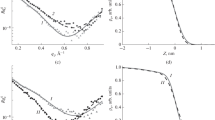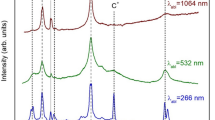Abstract
The microhardness of silicon epilayers grown from Sn fluxes is found to be lower than that of the silicon substrates and to significantly depend on the crystallographic orientation of the substrates. The microhardness values follow a Gaussian distribution in all of the epilayers. Unintentional impurities are shown to have a significant effect on the microhardness of the epilayers. The addition of ytterbium to the high-temperature solution reduces the microhardness of the epilayers.
Similar content being viewed by others
References
Binetti, S., Pizzini, S., Cavallini, A., and Fraboni, B., Erbium Doped Silicon Epilayers Grown by Liquid Phase Epitaxy, Phys. Tech. Semicond., 1999, vol. 33, no. 6, pp. 642–643.
Gerasimov, A.B. and Chiradze, G.D., Influence of the Nature and Concentration of Shallow Impurities on the Microhardness and Photomechanical Effect of Semiconductors, Fiz. Tekh. Poluprovodn. (S.-Peterburg), 2001, vol. 36, no. 4, pp. 385–386.
Kulish, U.M., Gamidov, Z.S., and Kuznetsova, I.Yu., Microhardness of Rare-Earth-Doped GaAs Epilayers, Izv. Akad. Nauk SSSR, Neorg. Mater., 1989, vol. 25, no. 10, pp. 1741–1743.
Arbenina, V.V. and Kabanova, E.G., Mechanical Properties of Doped Gallium Arsenide Epilayers, Neorg. Mater., 1999, vol. 35, no. 12, pp. 1420–1424 [Inorg. Mater. (Engl. Transl.), vol. 35, no. 12, pp. 1213–1216].
Brinkevich, D.I., Vabishchevich, S.A., Vabishchevich, N.V., et al., Effect of Rare-Earth Doping on the Microhardness of Silicon and Germanium, Neorg. Mater., 2003, vol. 39, no. 11, pp. 1287–1289 [Inorg. Mater. (Engl. Transl.), vol. 39, no. 11, pp. 1109–1111].
Vabishchevich, S.A., Vabishchevich, N.V., and Brinkevich, D.I., Microhardness of Silicon Wafers after Gettering Treatment, Perspekt. Mater., 2005, no. 2, pp. 20–22.
Nistiryuk, I.V. and Seregin, P.P., State of Tin Impurity in Silicon, Fiz. Tverd. Tela (Leningrad), 1975, vol. 17, no. 4, pp. 1192–1194.
Kalosha, V.K., Lobko, S.I., and Chikova, T.S., Matematicheskaya obrabotka rezul’tatov eksperimenta (Mathematical Methods for Data Processing), Minsk: Vysshaya Shkola, 1982.
Mezhennyi, M.V., Yugova, T.G., Bochkarev, A.E., et al., Composition-Dependent Microhardness of Epitaxial Layers of Quaternary Solid Solutions between III–V Compounds, Izv. Akad. Nauk SSSR, Neorg. Mater., 1990, vol. 26, no. 8, pp. 1601–1604.
Gerasimov, A.B., Chiradze, G.D., Kazarov, R.E., et al., Physical Nature of Microhardness Variations with Depth, Fiz. Khim. Obrab. Mater., 2004, no. 3, pp. 71–74.
Glazov, V.M. and Vigdorovich, V.N., Mikrotverdost’ metallov i poluprovodnikov (Microhardness of Metals and Semiconductors), Moscow: Metallurgiya, 1969.
Brinkevich, D.I., Vabishchevich, S.A., and Petrov, V.V., Effects of Group IIIB and IV Impurities on the Microhardness of Single-Crystal Silicon, Mikroelektronika, 1997, vol. 26, no. 4, pp. 297–300.
Brinkevich, D.I., Kazyuchits, N.M., Kryukov, V.L., et al., Silicon Epilayers Grown from Sn-Based Fluxes, Neorg. Mater., 1992, vol. 28, no. 3, pp. 472–475.
Sapaev, B., Saidov, A.S., and Ibragimov, Sh.I., Photoelectric Properties of Si Epilayers Grown from Sn-Metallurgical-Grade Si Melts, Pis’ma Zh. Tekh. Fiz., 2005, vol. 31, no. 12, pp. 56–62.
Sapaev, B. Lifetime of Minority Carriers in Polycrystalline Silicon Treated in Liquid Solvents, Pis’ma Zh. Tekh. Fiz., 2003, vol. 29, no. 20, pp. 64–68.
Shrikov, V.V., Pavlyna, O.V., and Shirokov, O.V., Effect of Dynamic Blocking of Dislocations by Interstitial Atoms on Mechanical Properties of Metals and Alloys, Funct. Mater., 2004, vol. 11, no. 2, pp. 405–409.
Borshchenskii, V.V., Brinkevich, D.I., Gorbacheva, N.I., et al., Influence of Germanium and Gadolinium Doping on the Thermal Stability of Single-Crystal Dislocation-Free Silicon, Vysokochist. Veshchestva, 1991, no. 4, pp. 61–64.
Afanas’eva, N.P., Brinkevich, D.I., Prosolovich, V.S., and Yankovskii, Yu.N., Lanthanide Doping of Silicon As a Way of Enhancing the Performance of Nuclear Detectors, Prib. Tekh. Eksp., 2002, no. 3, pp. 24–26.
Author information
Authors and Affiliations
Corresponding author
Additional information
Original Russian Text © D.I. Brinkevich, S.A. Vabishchevich, V.S. Prosolovich, 2007, published in Neorganicheskie Materialy, 2007, Vol. 43, No. 10, pp. 1159–1163.
Rights and permissions
About this article
Cite this article
Brinkevich, D.I., Vabishchevich, S.A. & Prosolovich, V.S. Microhardness of silicon layers grown by liquid phase epitaxy. Inorg Mater 43, 1035–1039 (2007). https://doi.org/10.1134/S0020168507100019
Received:
Accepted:
Issue Date:
DOI: https://doi.org/10.1134/S0020168507100019




